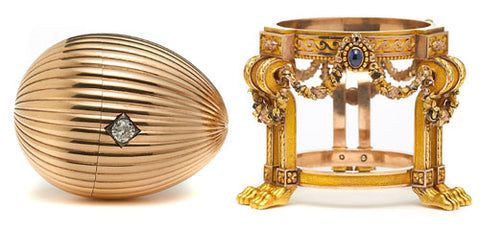Scrap Dealer Buys Genuine Fabergé Egg at Flea Market for $14,000; Once Prized by Russian Royalty, It Could Be Worth $33 Million
March 24th, 2014
A Midwestern scrap metal dealer made the find of a lifetime when he unknowingly scooped up a genuine Fabergé egg at a flea market for $14,000.

His original intention was to make a quick profit by melting down the egg for its gold content, but he soon learned that he possessed one of the eight missing Fabergé imperial eggs that dated back to the late 19th century. The value of the jewel-encrusted egg once prized by Russian royalty is estimated at $33 million.

The Fabergé egg measures slightly more than three inches tall and is distinctive because it has a ladies Vacheron Constantin watch cleverly hidden in its top half. The watch has a white enamel dial and openwork diamond-set gold hands.
When the scrap dealer Googled the words “egg” and “Vacheron Constantin,” he came up with an article about the lost Fabergé eggs and an image that seemed to match his flea market find.
Quoted as an expert in the article was Kieran McCarthy of Wartski, a British art and antiques dealer, so the scrap metal dealer decided to head to London with a photograph to attempt to verify the authenticity of his piece.
After viewing the photo and then visiting the piece in person, McCarthy was able to confirm that the egg was made in the workshop of Fabergé's chief jeweler, August Holmström, in St. Petersburg, Russia, in 1886 or 1887. It was given by Czar Alexander III to his wife, Empress Maria Feodorovna, as an Easter gift in 1887.

Wartski noted that the jeweled and ridged yellow gold egg stands on its original tripod pedestal, which has lion paw feet. The egg is encircled by golden garlands suspended from cabochon blue sapphires topped with diamond-set bows.
“The second I saw it, my spine was shivering,” McCarthy told the Associated Press, adding that the egg is a “Holy Grail” for collectors.
After the Russian Revolution, the egg somehow lost it provenance and made its way westward. It was sold at a New York auction in 1964 for a mere $2,450. The auction house’s description of the egg makes no mention of Fabergé.

McCarthy also reported that Wartski helped negotiate the sale of the egg to an unnamed collector for an undisclosed price. That sum is presumed to be upwards of $33 million.
Fabergé created exactly 50 imperial eggs for the Russian royal family, and seven still remain missing after this most recent find. Only three of the seven are believed to have survived the Russian Revolution.
The flea market Fabergé egg will be on display at Wartski in London from April 14 to 17. It’s the first time in more than a century that the public has gotten a glimpse of this historical piece.
Photos: Courtesy Wartski


Leave a comment